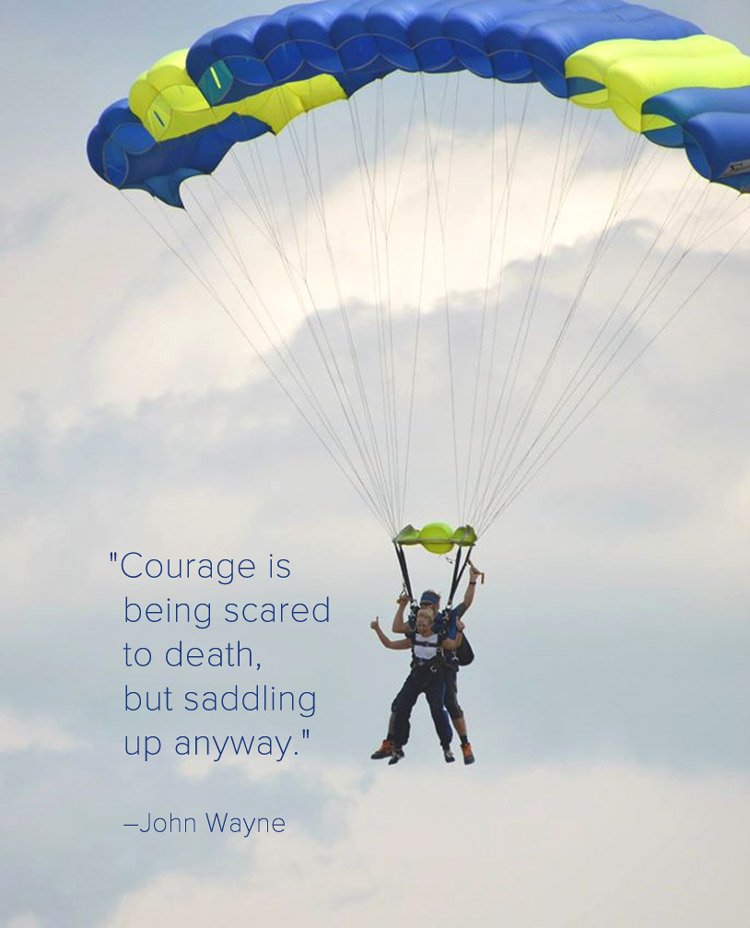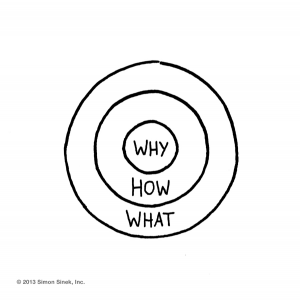
Mar 28, 2016 | Leadership, Personal Brand

Before we get into offering a few tools and practices to help you develop your leadership brand, let’s get clear on what we mean when we say “the brand of you.”
Your personal brand is what people say about you when you’re not in the room. It’s not what you say…it’s what other people say about you that counts here. What others convey about you is what creates your reputation, and it stays around a long time.
You already have a brand whether you are aware of it or not. With every behavior you exhibit, you’re making impressions on others, from what you say or do to how you react and interact – all of which can be an asset or a liability as you engage in the tasks and roles of leadership. It’s important to get conscious about it and proactively shape and define how you most want to show up and be seen in the world, influence others, and get results. The bottom line is, you can’t just rely on your skillset and expertise to be effective and get the job done.
So, the question is: “Is your brand what you want it to be?” The good news is everyone has a chance to stand out. And this is your opportunity to learn, grow your skills, and present yourself as you most desire. As you work on your brand, keep in mind that it is not about faking anything. It’s about surfacing and polishing behaviors and skills that allow your authentic, true self to be seen and be most effective. Think of it as starting today – you are a brand. How and for what do you want to be known?
Crack open a sense of possibility without limits. Think of your brand as your unique promise of value. It is your vision of who you are being and what you can do, bring, and deliver. It is a message that distinguishes you from everyone else by expressing what makes you unique and memorable. What brand are you today? Would you change anything about it? What will your personal brand be in a year?
Fortunately, you can have a great deal of control over the image others have of you. Laura Morgan Roberts of Harvard Business School puts it this way:
“People manage impressions through their nonverbal behavior (appearance, demeanor), verbal cues (vocal pitch, tone, and rate of speech, grammar, and diction), and demonstrative acts (citizenship, job performance).”
Crafting your image, or brand, requires you first to gain a clear picture of the image people currently perceive of you, then to decide what brand you would like to portray, and finally to develop the skills to close the gap. Let’s get started by having you explore a few questions as you consider your brand.
- If your brand is what other people say about you when you’re not in the room, what would your staff say? Consider peers, direct reports, and your boss. Don’t just stop at the office, but consider too what your spouse or partner would say. How about your children, siblings, and friends?
- What is the brand for which you think you are currently known? (List a few adjectives to describe you.)
- What is your unique offering, or what is it that you feel you uniquely deliver?
- What are your distinct quirks, characteristics, qualities, or gifts?
- What is the ‘look’ and ‘feel’ of brand YOU? A fun thing to consider: If you were a dog, what breed of dog would you be? Or if you were a car, what brand or model?
- If you had a leadership brand tagline – think Nike and “Just Do It” – what would it be?
- Is there alignment between your perceptions of what others think and your impressions of yourself? Ask for feedback.
You are in charge of your leadership brand, so invest in your learning and development as a leader. Think about your current job and your career path – how does your leadership brand support your work today? What 1 or 2 things might you tweak to help you be more effective? What do you need to learn or change to improve your leadership skills and impact?
A leader’s brand is constantly being created. Once you have taken a close look at your brand, the best strategy for crafting your brand is to practice. An effective leadership brand that seems instinctive or unconscious is very likely not. It takes skill and practice to be comfortable in your leadership role and have a brand to match. Here are some opportunities that permit you to practice behaviors. Can you think of others?
- One-on-one meetings
- Public presentations
- Board meetings
- Media interviews
- Interacting in the hallway, cafeteria, or parking lot
- Traveling with others on business
- Events or locations outside of work
In closing, I challenge you to live your leadership brand. One of my life maxims is “Act As If.” Whatever you most desire your brand and image to be, go ahead and live into it. Eat as if, walk as if, sleep as if…you get the picture. Once you have defined that unique thing that is wholly YOU, integrate that uniqueness into all you do, say, write, and create. Don’t wait another minute to get started!
Resources and Suggested Reading
Criswell, C., & Campbell, D. (2008). Building an Authentic Leadership Image. Greensboro, NC: Center for Creative Leadership.
Peters, T. (1999). The Brand Called You. New York, NY: Knopf Doubleday Publishing Group.
 About Jeanie Duncan: Jeanie is President of Raven Consulting Group, a business she founded that focuses on organizational change and leadership development in the nonprofit sector. She is a senior consultant for Raffa, a national firm working with nonprofit clients to lead efforts in sustainability and succession planning, executive transition and search. Additionally, Jeanie serves as adjunct faculty for the Center for Creative Leadership, a top-ranked, global provider of executive leadership education.
About Jeanie Duncan: Jeanie is President of Raven Consulting Group, a business she founded that focuses on organizational change and leadership development in the nonprofit sector. She is a senior consultant for Raffa, a national firm working with nonprofit clients to lead efforts in sustainability and succession planning, executive transition and search. Additionally, Jeanie serves as adjunct faculty for the Center for Creative Leadership, a top-ranked, global provider of executive leadership education.

Jul 21, 2015 | Courage, Intention, Leadership

This quote has always been a favorite of mine. And it’s taking on new meaning after going skydiving with a girlfriend and our sons. It was an exhilarating experience with many rich take-a-ways.
Skydiving is something I’ve always been terrified of, but really wanted to do. When I stop to think about it, it’s not often words like ‘terror’ and ‘desire’ go together in the same sentence.
I believe most of all, I wanted to prove to myself that I could be that afraid of something and still do it. I had this unbridled anticipation that if I could just do it, it would be one of the most amazing experiences ever – soaring, floating, free.
It was all of that. And more.
For a long time, my fear paralyzed this dream. Eventually, I grew tired of hearing my own whining voice (as did my friends), continually expressing my longing to do it and talking myself out of it with endless excuses. I decided – ENOUGH! It’s time to accept my fear and move directly into it.
Having now taken the leap, I realize the powerful metaphor that skydiving is for both fear and freedom. As for fear, there are many things that I’m afraid of. Yet, when I face the fear head-on, it often vanishes…or at least shrinks. And there in its place is a surprising gift – freedom.
This plays out for me in work situations like public speaking and dealing with a challenging client situation, or on the personal side such as sailing in intense conditions with high winds or heavy weather, or mountain biking a technically difficult trail.
This experience is a reminder to examine the task and its importance, purpose, and impact, while weighing the risks and rewards.
A little part of me even believes that acting on this insane courage unlocks some deep, hidden ‘magic power.’ That now – from out of nowhere! – I will leap tall buildings and blast fire from my fingertips…or at least the mortal equivalent of having greater confidence and faith that I ‘can do it’ and it will all work out.
Lastly, I’m left thinking of everything I would have missed had I stopped short of jumping. Bold moves launch us out of our comfort zone and open us up. You can’t help but expand when free falling 120 mph at 12,000 feet! I’ll never see things quite the same again.
Lessons in courage from skydiving:
- Embrace fear and take action anyway. I don’t think it’s about overcoming the fear or that it goes away.
- With any given situation, explore the worst-case scenario, gauge your comfort level, tap into your resources, and work backward to develop a plan from there.
- Take action that helps make you more comfortable. In this case of skydiving, I consulted with others who had done it and sought their advice, researched (exceptionally) reputable skydiving companies to ensure they have (highly) trained professionals and excellent equipment. Risk mitigation!
- Do things often that take your breath away.
- Get out of your comfort zone…sometimes far, far outside. This is where real learning and living takes place. Life is more fun and interesting if it is a series of amazing adventures.
- Be fully present in life – the skydiving free-fall lasts only 60 seconds, and the entire experience is over in 7 minutes. The impact; however, lasts a lifetime.
- Surround yourself with spicy friends who’ll call you out on living small.
 About Jeanie Duncan: Jeanie is President of Raven Consulting Group, a business she founded that focuses on organizational change and leadership development in the nonprofit sector. She is a senior consultant for Raffa, a national firm working with nonprofit clients to lead efforts in sustainability and succession planning, executive transition and search. Additionally, Jeanie serves as adjunct faculty for the Center for Creative Leadership, a top-ranked, global provider of executive leadership education.
About Jeanie Duncan: Jeanie is President of Raven Consulting Group, a business she founded that focuses on organizational change and leadership development in the nonprofit sector. She is a senior consultant for Raffa, a national firm working with nonprofit clients to lead efforts in sustainability and succession planning, executive transition and search. Additionally, Jeanie serves as adjunct faculty for the Center for Creative Leadership, a top-ranked, global provider of executive leadership education.

Jun 9, 2015 | Conflict Management, Leadership, Transition & Change

Much of my work focuses on organizations and leaders in transition. Often, individuals are transitioning from a member of an internal team to the leader of that team…or the entire organization.
Many personalities reflect on their transition as significant and sweeping – their worlds changing so quickly they can be left feeling like a stranger in their own land. Almost overnight, the playing field changes from interacting as a peer or direct report of a colleague to that of “the boss.” They’re left out of the informal “hall talk” and invitations to gather after work, where only days before they were a part of the inside loop.
To this individual, they’re still the same person who knows and works with the same people, but the hierarchy dynamic has shifted, and with it, the new leader must adapt and grow in how s/he manages interpersonal relationships as well as the challenges, issues, and conflicts that come with it.
It’s in this context that I share the following tips to acclimate to this new reality:
Developing strong interpersonal relationships:
- Help your team get to know you in this new role. Exhibit your leadership brand and capabilities in a way that engenders confidence and trust.
- Go on a ‘listening tour.’ Visit with your colleagues and seek their thoughts and input about priorities and what’s important to them. What do they feel is critical to accomplish in the near term – both for them in their role as well as the team and the organization?
- Keep in mind that groups often make the best decisions because the group process increases commitment to the decision. Help your direct reports develop analytical skills by including them in decision making.
- Develop a culture of experimentation and innovation. Let your people know it’s safe to try new things that support problem solving and excellence…and that you’ll support them.
- Share your vision and leadership agenda with your direct reports and help them see their role in forwarding those priorities. Work to advance the scope of work collectively and celebrate success together along the way.
- Support your team in times of change and transition. If you’re new in your leadership role – now leading people who previously were your peers – this change can be unsettling to those around you. Fear and loss play a large role in resistance to change. Individuals wonder how the adjustment will directly impact them, for example: how will you relate to them differently through this role change and how might their priorities and responsibilities change. Listen and acknowledge those feelings. Often these issues and anxiety arise from a lack of information.
Managing conflict with direct reports:
- Know your part in the conflict: Conflict has multiple sides. Be sure to take ownership of your part in the conflict, and get a clear picture of how you might be contributing. A 360 assessment might be a helpful tool in gathering information to offer insight into your behavior and performance.
- Clarify objectives and expectations: Make sure you’ve made your objectives clear to your direct reports and that you communicate the goal when starting new initiatives. Team members need to know their tasks, the final objectives, and how success will be measured. Have them describe their understanding to confirm alignment. Many performance problems that spark conflict between managers and their team most commonly stem from a misunderstanding of expectations.
- Consider solutions other than your own: Be flexible and think beyond your perspective. View the world through the eyes of your direct reports and try to understand and incorporate their ideas and points of view.
- Know your emotional triggers: All of us have emotional triggers that can result in behavior that creates conflict. Know what sets you off and pay attention to your physical cues such as a rapid heartbeat or a rise in body temperature. Practice techniques to bring these reactions into check and temper your response.
- Move quickly to resolve issues: It’s a natural human tendency to avoid conflict. Be willing to confront situations head on and have ‘courageous conversations’ to develop common ground, arrive at a solution that works for all, and prevent matters from simmering and later erupting into conflict.
- Prepare a strategy for managing the situation: Consider how you establish trust with your direct reports so your communication can be honest and effective and be delivered with respect and empathy. Before engaging in the actual encounter to resolve conflict, reflect on your plan for the interaction and anticipate questions and objections.
Different points of view, values, and ways of working are sure to spark conflict. It’s simply inevitable…and an experience that successful leaders must learn to address. The special relationship between managers and direct reports requires all involved to practice active listening, develop an understanding of multiple perspectives, and possess a willingness to reframe points of view. A focus on behavior and openness to new solutions will go a long way toward building stronger interpersonal relationships and trust, and resolving conflict along the way.
________
Popejoy, B., & McManigle, B.J. (2002). Managing conflict with direct reports. Greensboro, NC: Center for Creative Leadership.
Also read these related posts:
Perspectives on Conflict with Your Boss
Team Trust – Critical Yet Rare
Into the Storm: Mastering Team Conflict
A Process for Managing Peer Conflict
 About Jeanie Duncan: Jeanie is President of Raven Consulting Group, a business she founded that focuses on organizational change and leadership development in the nonprofit sector. She is a senior consultant for Raffa, a national firm working with nonprofit clients to lead efforts in sustainability and succession planning, executive transition and search. Additionally, Jeanie serves as adjunct faculty for the Center for Creative Leadership, a top-ranked, global provider of executive leadership education.
About Jeanie Duncan: Jeanie is President of Raven Consulting Group, a business she founded that focuses on organizational change and leadership development in the nonprofit sector. She is a senior consultant for Raffa, a national firm working with nonprofit clients to lead efforts in sustainability and succession planning, executive transition and search. Additionally, Jeanie serves as adjunct faculty for the Center for Creative Leadership, a top-ranked, global provider of executive leadership education.

Mar 21, 2015 | Conflict Management, Leadership
 As a sailor, when I see a storm building on the horizon, I intentionally alter my path to circumvent the system – tacking to port or starboard, or identifying a cove or marina to head into for safety…anything to escape the danger that lies ahead.
As a sailor, when I see a storm building on the horizon, I intentionally alter my path to circumvent the system – tacking to port or starboard, or identifying a cove or marina to head into for safety…anything to escape the danger that lies ahead.
In the business setting, our human tendency is to do the same – avoid the storm, the conflict, that we see brewing. We are a conflict-adverse culture and society. Often, our last (or near last) resort is moving directly into the issue, tension, and challenge to attend to what must be addressed.
So, why is this? Why do we avoid addressing and resolving conflict? Why is it so difficult? Afterall, it’s often identified as one of the most important competencies required of top leaders to succeed. Beyond the fact that conflict is flat out uncomfortable, I believe our aversion is due to a few key things:
- Many of us learn early on in our formative years to avoid making waves, to listen to others, and be polite. Personally, as a female growing up in the southeastern United States, I often would say one thing and mean another – too afraid to share my true thoughts and risk offending someone. My parents, as well as others who shaped and influenced me early on, taught me that questioning and being direct was considered rude, bossy, and aggressive, so I simply didn’t practice it.
- When starting out in our careers, we’re young, new in a position, trying to gain an understanding of the office culture, and learning the political landscape. We’re encouraged (whether expressed or not) to be tactful and diplomatic – “keep your head down and get the job done” – or else become known as the difficult employee…sometimes risking losing our job altogether.
- When we advance and move from a role as an individual contributor to a role of leading others, the relationships necessary for working together often spawn conflict. Our tendency can be to revert back to what we know well – our individual strengths, whether technical, financial, sales, etc. – and avoid the sticky, messy group dynamics of gaining alignment and commitment to work toward a common goal. We can also avoid acting as a result of preservation (of relationships, tradition, etc.) and territory, digging our heels in to protect our own viewpoints, values, and beliefs and refuse to move.
Conflict is difficult for a number of reasons – those mentioned above and others you can surmise. But difficult as it may be, addressing and resolving conflict is critically important to individual and organization success. It begins with defining what conflict is in the first place and understanding it as something to be dealt with instead of avoided.
At its core, conflict is disharmony and discord between people, interests, or ideas. It’s also natural to the human experience. Where there are people, there will be conflict. Afterall, people are emotional beings. We have deeply held beliefs, values, and experiences that have shaped who we are. We’re bound to bring this into how we express ourselves, make decisions, and communicate with one another. And when we do, we will differ, disagree, and sometimes clash. The key to making it work and being effective, is to learn to have open, honest debate and dialogue around issues of importance to the team. It can only happen if vulnerability-based trust exists.
Teams without trust often argue destructively because they are laced with politics, pride, and competition, rather than humble pursuit of truth. When trust exists, team members say everything that needs to be said and it leaves less to talk about behind closed doors. Conflict is always at least a little uncomfortable. And it’s inevitable that people will feel under some degree of personal attack. This is still no reason to avoid conflict.
As Patrick Lencioni states in his book, The Five Dysfunctions of a Team, “If team members are not making one another uncomfortable at times, if they’re never pushing one another outside of their emotional comfort zones during discussions, then it is extremely likely that they’re not making the best decisions for the organization.”
The problem around conflict that I most often see in relationships and teams is artificial harmony with no conflict at all, coupled with great fear of moving in that direction. It reminds me of a friend who told me that he and his girlfriend of two years had never had an argument. He shared this as a point of pride; however, I see this as a warning sign. The ability to have healthy, productive conflict is a symbol of maturity and sustainability in a relationship. When a relationship or team shows that it can survive an incident of significant conflict, it builds greater trust and confidence in the relationship.
Let’s examine a few key practices to engaging in and managing team conflict:
- Begin with trust building exercises. A team (or a relationship of any kind) and its members must know and trust one another before it can engage in courageous conversations and move into and through conflict together. (See key tips in my blog post: Team Trust – Critical Yet Rare)
- Identify “rules of engagement” and how you will address conflict together. Establish clear norms, keep these visible and present, and hold everyone accountable for what they’ve agreed upon. It’s important to ensuring a productive exchange of ideas.
- Gain clarity on viewpoints and comfort levels with conflict, because they can differ greatly. On one extreme are the people who are comfortable arguing passionately; on the other are those who are not comfortable expressing the mildest of dissention. Know where your team members fall, why they fall there, and what’s important to them as you work together to address conflict.
- Be clear on role clarity and alignment. Individual team members need to be crystal clear on their own role, how their role supports the team’s work, and how the collective team’s work supports the organization’s mission.
- Create a feedback rich environment in the spirit of understanding one another’s behaviors and the impact of those behaviors on teamwork and effectiveness. Foster a culture that encourages team members to give feedback to one another in a positive, non-judgmental manner, and then members use that feedback to shape and adapt their behaviors to yield the greatest results.
- Leaders must be miners of conflict. It’s important for a leader “not only to light the fuse of good conflict, but also to gently fan the flames,” states Lencioni. “Even when team norms for conflict have been set, most people will shy away from conflict.” Seek out opportunities for unearthing buried conflict and require team members to address the issues. An issue lying dormant is merely simmering beneath the surface and can be on the verge of erupting…or can quietly undermine progress.
Given human nature and the pressures of organizational life, there’s likely to always be conflict wherever people are together. But this conflict can be managed so that it’s a productive encounter that leaves individuals engaged in their work, honored and supported for their ideas and beliefs, and the organization on a path to mission delivery success.
_______
Lencioni, P. (2005). Overcoming the five dysfunctions of a team: a field guide. San Francisco: Jossey-Bass.
Also read these related blog posts:
Perspectives on Conflict with Your Boss
Bridge the Divide of Conflict with Direct Reports
Team Trust – Critical Yet Rare
A Process for Managing Peer Conflict
 About Jeanie Duncan: Jeanie is President of Raven Consulting Group, a business she founded that focuses on organizational change and leadership development in the nonprofit sector. She is a senior consultant for Raffa, a national firm working with nonprofit clients to lead efforts in sustainability and succession planning, executive transition and search. Additionally, Jeanie serves as adjunct faculty for the Center for Creative Leadership, a top-ranked, global provider of executive leadership education.
About Jeanie Duncan: Jeanie is President of Raven Consulting Group, a business she founded that focuses on organizational change and leadership development in the nonprofit sector. She is a senior consultant for Raffa, a national firm working with nonprofit clients to lead efforts in sustainability and succession planning, executive transition and search. Additionally, Jeanie serves as adjunct faculty for the Center for Creative Leadership, a top-ranked, global provider of executive leadership education.

Feb 23, 2015 | Leadership

The foundation of any highly functioning team is trust. While critically important, it can be rare among teams, and we all know it takes time and intentional practice to build. Trust is all about vulnerability – get comfortable being open, honest, and ‘exposed’ to one another around failures, challenges, and areas for development and trust begins to emerge. The process is well worth the effort invested and can be cultivated with sustained intention, purpose, and focus.
In many workplaces, what we find is a group of individuals who have been hired over time and are expected to begin working together without any prior relationships or baseline of trust being formed. They may even call themselves a team, but in reality, they’re individual performers charged with accomplishing a group goal. This is very different from a “team.” And it’s not a formula for success, especially in light of challenges and potential conflict inherent to any project or task.
Try these trust-building exercises to help develop a strong, highly functioning team:
- In his book “Overcoming the Five Dysfunctions of a Team,” Patrick Lencioni shares the Personal Histories Exercise. It works like this: At a staff meeting, go around the room and have each person respond to a question (or questions) that requires them to share something personal and relevant. For example, the author offers this three-part question: 1) Where they grew up, 2) How many kids were in the family, and 3) What was the most difficult or important challenge of their childhood. In responding, the group learns a lot about one another, and in the process, they become more comfortable being open about other things. Empathy develops, and it also helps individuals overcome what Lencioni calls the fundamental attribution error, where we tend to falsely attribute the negative behaviors of others to their character (false conclusion: people do bad things because they’re bad).
- Administer a behavioral assessment with a team – a tool that will provide an objective, reliable means for understanding and describing one another. There are many from which to select – Meyer’s Briggs, DISC, Strengths Deployment Inventory, to name a few – and each can be an effective means to self-identify their ‘type’ and provide a common vocabulary to describe similarities and differences. Such a tool can be completed with a team in as little as a couple of hours or extended to a half- or full-day experience.
- Another proven way for a team to learn to work together to build trust is to attend a high initiative or ropes course. This experience typically takes at least a half-day and is offered to teams by independent training organizations. Hanging at the end of each other’s rope is a great way to increase risk taking and trust levels, using an ultra safe and highly supervised course.
Key to making any of these exercises work is to anticipate initial objections and have proper facilitation. These experiences, when implemented well, can establish a foundation of team trust and set a path for achieving great results together.
_______
Lencioni, P. (2005). Overcoming the five dysfunctions of a team: a field guide. San Francisco: Jossey-Bass.
Also read these related blog posts:
Perspectives on Conflict with Your Boss
Bridge the Divide of Conflict with Direct Reports
Into the Storm: Mastering Team Conflict
A Process for Managing Peer Conflict
 About Jeanie Duncan: Jeanie is President of Raven Consulting Group, a business she founded that focuses on organizational change and leadership development in the nonprofit sector. She is a senior consultant for Raffa, a national firm working with nonprofit clients to lead efforts in sustainability and succession planning, executive transition and search. Additionally, Jeanie serves as adjunct faculty for the Center for Creative Leadership, a top-ranked, global provider of executive leadership education.
About Jeanie Duncan: Jeanie is President of Raven Consulting Group, a business she founded that focuses on organizational change and leadership development in the nonprofit sector. She is a senior consultant for Raffa, a national firm working with nonprofit clients to lead efforts in sustainability and succession planning, executive transition and search. Additionally, Jeanie serves as adjunct faculty for the Center for Creative Leadership, a top-ranked, global provider of executive leadership education.

Feb 10, 2015 | Leadership
I recently completed some forecasting and goal setting for my business. As I went through this process, I pulled from several resources that inspire and motivate me, a favorite of which is Simon Sinek’s “Start With WHY.” He expresses his message through what he calls The Golden Circle:

His premise is that you must begin with your WHY, and from there figure out your HOW and WHAT. When Sinek studied successful leaders, he found a common denominator – they inspire through a clearly and passionately articulated WHY. They hold their WHY front and center – like a North Star – to guide their WHAT and HOW. Everything emerges from the core WHY, or belief. HOWs are the actions they take to realize that belief. And WHATs are the results of those actions.
I’ve known about Sinek’s philosophy for a while, but I find even greater meaning in it now – not only for my own personal and business reflection, but also for my clients.
According to this line of thought, most every person and organization knows WHAT they do. That’s usually pretty clear. Some know HOW they do it. But very few know WHY they do WHAT they do. Or at least they don’t stop to think about it or articulate it frequently and consistently.
By WHY, Sinek doesn’t mean ‘to earn revenue,’ but rather, he’s referring to your purpose, your cause, your belief. Sinek asks, “WHAT makes you get out of bed in the morning? WHY do you care? And WHY should others care?” Think of it as communicating from the inside out.
Think for a moment – We busily go about our day-to-day. We take on roles, assignments, projects, and business…and before long we’ve amassed this huge volume of ‘stuff’ without pausing to think about WHY we’re doing it. Even if we know our WHY, we can fail to consciously use it as our lens or filter for making decisions.
As I went through my own reflection, I see room for getting clearer with my own “WHY” and doing a better job of sharing my story.
A theme for me over my life is that I’m a self-starter and risk taker. I grew up in an entrepreneurial family with my parents owning two businesses. My siblings and I were involved in those businesses where there was no task too great or small; we all pitched in to get it done. And if we didn’t know how to do it, we figured it out. Failures were acknowledged as just one step closer to succeeding.
When I finished college, my first jobs were new positions where I was responsible for creating the role. Later on, I set my vision and sites for what I wanted and set out to achieve it, including starting my own business. Through it all, I didn’t have all the information, the guidelines were ambiguous, and I needed to perform and produce results fast. I quite like this messiness – stepping into the unknown, bringing order to chaos, and charting a course where there isn’t one.
This pattern and energy shapes my WHY – To help people know WHAT they want, find their courage, step forward, and take risks. This is the path to which my life and my work is devoted.
Sinek offers, “People don’t buy WHAT you do. They buy WHY you do it. People don’t buy WHAT you sell. They buy WHAT you believe. And people follow you not because they have to, not because they are paid to, but because they want to.”
This concept comes alive every day in business:
- Strategy Development: For an organization to develop its goals, strategies, and tactics, it must first be crystal clear on its WHY, often presented most succinct in a well-crafted vision and mission. As Sinek offers, “It’s not just WHAT or HOW you do things that matters; what matters more is that your WHAT and HOW is consistent with your WHY.” With a WHY clearly stated in an organization, anyone within the organization can make a decision as clearly and as accurately as the top leader.
- Sustainability Planning: The products and services offered by many organizations are broad and complex. It’s important to critically and regularly examine these lines of business and ask, “WHY do we do this,” looking at both mission impact and financial return to gauge long-term sustainability. Yet, we can get so caught up in the day-to-day, that our WHAT mutates into a complex web without a clear connection to vision and mission, and with limited (or lost) return on investment.
- Succession Planning and Leadership Transitions: Sinek concludes that top executives are successful in great part because they inspire and embody what they believe. When the person who personifies the WHY departs without clearly articulating WHY the company was founded in the first place, they leave no clear cause for their successor to lead. “Successful succession is more than selecting someone with an appropriate skill set – it’s about finding someone who is in lockstep with the original cause around which the business was founded. Great 2nd and 3rd CEOs don’t take the helm to implement their own vision of the future; they pick up the original banner and lead the company into the next generation.”
I encourage you to get to your WHY. It yields greater confidence than ‘I think it’s right.’ It’s more scalable than ‘I feel it’s right.’ When you know your WHY, the highest level of assurance you can offer is, ‘I know it’s right.’
_______
Sinek, S. (2009). Start with why: how great leaders inspire everyone to take action. New York: Penguin Group.
 About Jeanie Duncan: Jeanie is President of Raven Consulting Group, a business she founded that focuses on organizational change and leadership development in the nonprofit sector. She is a senior consultant for Raffa, a national firm working with nonprofit clients to lead efforts in sustainability and succession planning, executive transition and search. Additionally, Jeanie serves as adjunct faculty for the Center for Creative Leadership, a top-ranked, global provider of executive leadership education.
About Jeanie Duncan: Jeanie is President of Raven Consulting Group, a business she founded that focuses on organizational change and leadership development in the nonprofit sector. She is a senior consultant for Raffa, a national firm working with nonprofit clients to lead efforts in sustainability and succession planning, executive transition and search. Additionally, Jeanie serves as adjunct faculty for the Center for Creative Leadership, a top-ranked, global provider of executive leadership education.


 About Jeanie Duncan: Jeanie is President of Raven Consulting Group, a business she founded that focuses on organizational change and leadership development in the nonprofit sector. She is a senior consultant for Raffa, a national firm working with nonprofit clients to lead efforts in sustainability and succession planning, executive transition and search. Additionally, Jeanie serves as adjunct faculty for the Center for Creative Leadership, a top-ranked, global provider of executive leadership education.
About Jeanie Duncan: Jeanie is President of Raven Consulting Group, a business she founded that focuses on organizational change and leadership development in the nonprofit sector. She is a senior consultant for Raffa, a national firm working with nonprofit clients to lead efforts in sustainability and succession planning, executive transition and search. Additionally, Jeanie serves as adjunct faculty for the Center for Creative Leadership, a top-ranked, global provider of executive leadership education.









